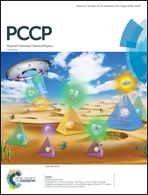Ultrafast excited-state relaxation of a binuclear Ag(i) phosphine complex in gas phase and solution†
Abstract
The binuclear complex [Ag2(dcpm)2](PF6)2 (dcpm = bis(dicyclohexylphosphino)methane) exhibits a structure with a close silver–silver contact mediated by the bridging ligand and thus a weak argentophilic interaction. Upon electronic excitation this cooperative effect is strongly increased and determines the optical and luminescence properties of the compound. We have studied here the ultrafast electronic dynamics in parallel in gas phase by transient photodissociation and in solution by transient absorption. In particular, we report the diverse photofragmentation pathways of isolated [Ag2(dcpm)2]2+ in an ion trap and its gas phase UV photodissociation spectrum. By pump–probe fragmentation action spectroscopy (λex = 260 nm) in the gas phase, we have obtained fragment-specific transients which exhibit a common ultrafast multiexponential decay. This is fitted to four time constants (0.6/5.8/100/>1000 ps), highlighting complex intrinsic photophysical processes. Remarkably, multiexponential dynamics (0.9/8.5/73/604 ps) are as well found for the relaxation dynamics in acetonitrile solution. Ab initio calculations at the level of approximate coupled-cluster singles-doubles (CC2) theory of ground and electronically excited states of the reduced model system [Ag2(dmpm)2]2+ (dmpm = bis(dimethylphosphino)methane) indicate a shortening of the Ag–Ag distance upon excitation by 0.3–0.4 Å. In C2 geometry two close-lying singlet states S1 (1MC(dσ*–pπ), 1B, 4.13 eV) and S2 (1MC(dσ*–pσ), 1A, 4.45 eV) are found. The nearly dark S1 state has not been reported so far. The excitation of the S2 state carries a large oscillator strength for the calculated vertical transition (266 nm). Two related triplets are calculated at T1 (3.87 eV) and T2 (3.90 eV). From these findings we suggest possible relaxation pathways with the two short time constants ascribed to ISC/IVR and propose from the obtained similar values in gas phase that the fast solution dynamics is dominated by intramolecular processes. A further relaxation by IC/IVR in the triplet manifold is likely to account for the observed intermediate time constants. For the acetonitrile relaxation dynamics additional modifications are invoked based on solvent-induced shifts of the energy levels and the possible formation of solvent and counterion exciplexes on a longer timescale.

- This article is part of the themed collection: 2017 PCCP HOT Articles


 Please wait while we load your content...
Please wait while we load your content...